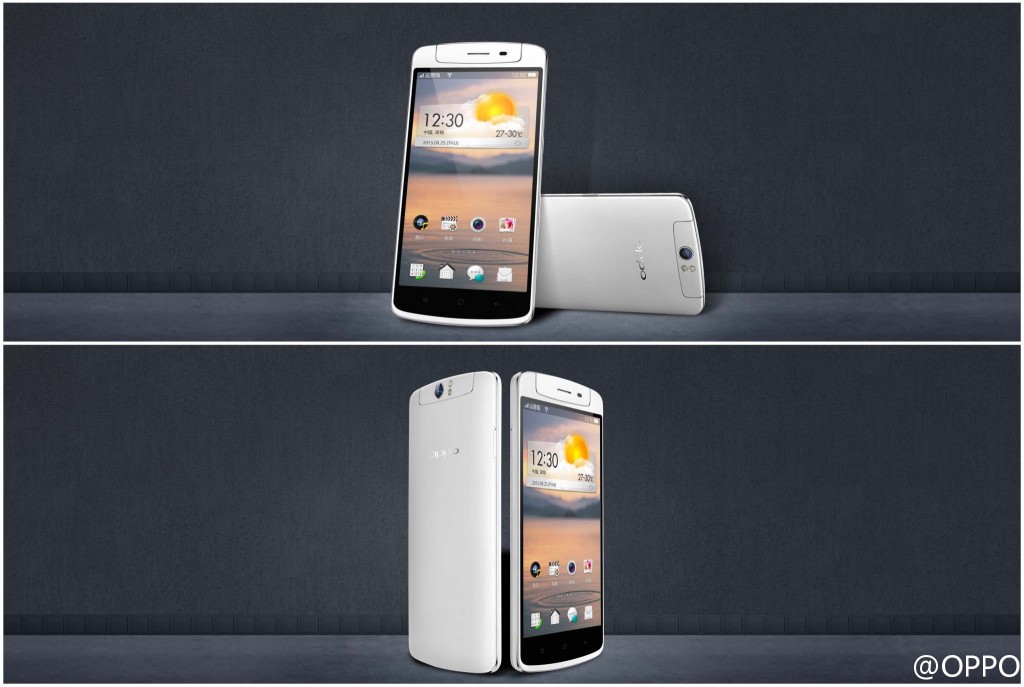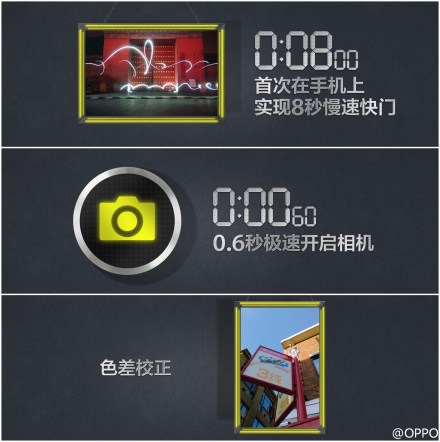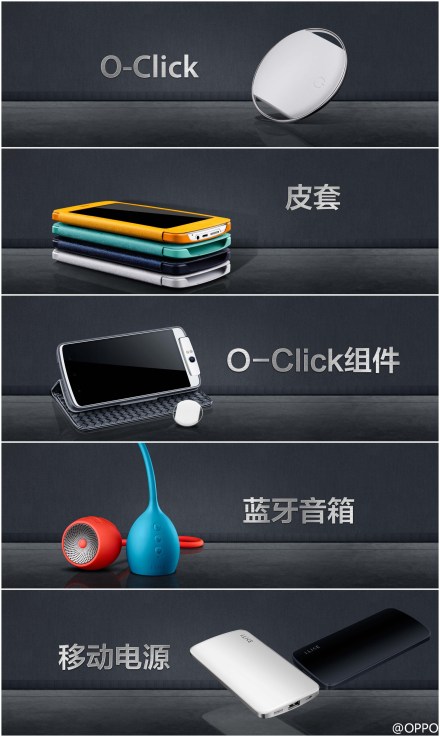Oppo have finally revealed all the details of their latest camera centric flagship device – the Oppo N1. The N1 was announced at an event in Beijing amidst much expectations, as we had detailed ours a while back. It has a 5.9 inch full HD resolution IPS display, a O-Touch rear sensor for single handed touch interaction on the back and is powered by a Qualcomm Snapdragon 600 Quad Core processor. At 5.9 inches, the device is huge and as a result, sports a massive 3610 mAH battery too. But the main USP is a 13 Megapixel Sony EXMOR RS Stacked CMOS Sensor camera, with a f2.0 aperture six element lens that sits on a rotating swivel and turns 206 degrees!
There is a boatload of new features Oppo has introduced, but lets go through the specifications first –
- 5.9 inch full HD 1920×1080 IPS LCD display
- Dimensions – 170.7 x 82.6 x 9 mm Weight – 213g
- 1.7 GHz Qualcomm Snapdragon 600 with Adreno 320
- 16/32 GB ROM, 2 GB RAM
- 13 Megapixel Stacked CMOS Sony sensor with dedicated ISP
- F2.0 Aperture, Dual LED flash and 1080p Video recording
- 3G, USB OTG, WiFi ac 5GHz, WiFi Direct, WiFi Display support
- 3610 mAh battery
- Android 4.2 – Color ROM pre-installed, unlocked bootloader
The price is set at 3,468 Yuan = 570 USD = 35,700 INR and is set for a December availability.
Now to expand on the highlights of the Oppo N1 –
13 Megapixel rotating swivel camera –
The camera on the Oppo N1 is a 13 Megapixel Sony EXMOR RS Stacked CMOS Sensor unit, the same as the Find 5, the Lenovo K900 and the Samsung Galaxy S4. It is a 1/3.06″ sensor that is complemented by a six element f2.0 aperture lens. The lens is coated with IR and Blue filters and Oppo boasts of reduced chromatic aberrations and purple fringing from the lens. The whole unit sits on a swivel-type arrangement that can rotate 206 degrees for using the same camera for front-facing as well as rear-facing shots.
The dual LED flash also works according to the orientations of the camera, with a powerful flash for the rear orientation and a diffused flash for the front orientation. Not only that the camera gets a dedicated ISP too, and Oppo says that it is custom made, tailored for the N1’s camera. it enabled a fast 0.6 second cold boot for the camera alone and even a 8 second long shutter speed for the camera. Oppo brands all these features under “Pure Image” or PI moniker.
O-Touch rear sensor
One of the prominent teaser campaigns before the launch of this device was the Rear touch functions of the N1, and it is called O-Touch now. Like we had seen earlier, you can either swipe left-right or top-bottom for all the common touch interactions, and configure a single long press action too, to open up a special app or a full screen widget. You can even snap a photo when using the camera, using the O-Touch area on the back. The surface area is 12cm^2 which is reasonably large for the back of a smartphone.
O-Click remote control
The O-Click remote control unit lets you remotely trigger the shutter of the N1’s camera. This is pretty useful for self-timer like shots of a group or any other usage one could think of. It’s really small and can go with a keychain. Not only that, you can also use it as a NFC remote to locate or track an object from the phone or vice versa, which works much like the rumoured Nokia Bluetooth Tag. The O-click comes bundled for free in the retail box. But there are also other accessories available for the N1, like a leather case, Bluetooth stereo speakers and, what looks like, a battery pack.
These are the highlights of the Oppo N1. You might also want to know that the device has been extensively sampled and tested to make sure all the design elements work right, for example, they have made sure that the swivel unit lasts 100,000 rotations to finalize the appropriate design and even got more than a dozen suppliers in line for producing its aluminium frame over a period of 20 days. If the Find 5’s build quality is anything to go by, we expect the N1 to look and feel similar, but the only concern is the weight, but that makes for an entirely different post, we’ll hold on to that.
Lastly, the Oppo N1 comes with the company’s own Color ROM pre-installed, which is a skinned version of Android 4.2. The International version will come with an unlocked bootloader and Oppo will provide options to load Cyanogen Mod through stock recovery options. But there is also a limited edition N1 that will come with Cyanogen Mod out of the box, making it the first ever hardware partner for the Cyanogen Mod Inc.
And that’s it folks. This is the Oppo N1.
What do you think of the N1’s highlights? Do you think the phone is more innovative than, say, the iPhone 5S? Sound off in the comments section below.




